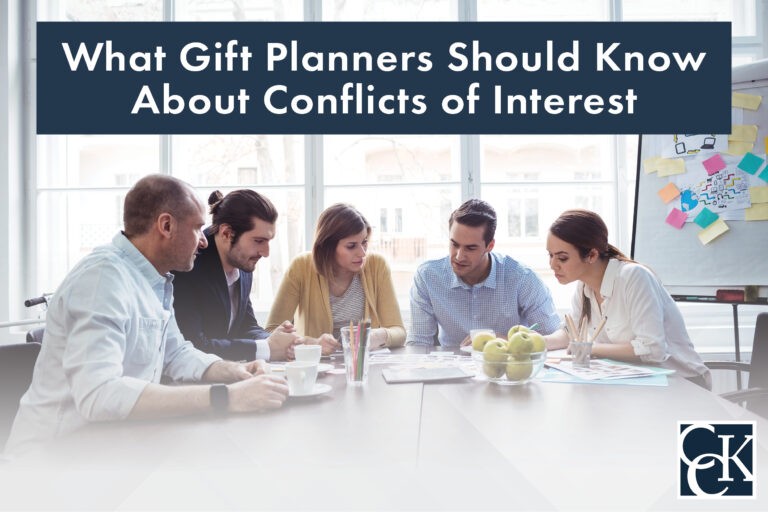What Gift Planners Should Know About Conflicts of Interest

In many charities, the gift planner is not only a fundraiser – (s)he may also function as a member of the senior management team. Perhaps better than anyone else, the gift planner knows that a charity’s future depends on its reputation, a reputation that depends on how it conducts its affairs.
Conflicts of interest are inevitable within organizations. Conflicts themselves are value-neutral, neither good nor bad. They become problematic only when they are overlooked, ignored, or not addressed in a prompt and effective way. Charities that can manage them merit kudos for good governance. It is always helpful for key players in charitable organizations to have a basic understanding of conflicts of interest.
What, exactly, is a conflict of interest?
A conflict of interest can exist when someone has divided loyalties. If those loyalties are competing and the person must choose one over the other, that is a conflict of interest requiring careful attention.
In the nonprofit world, conflicts of interest are frequently seen in the context of a charity “insider” (board member, executive, major donor) having the opportunity to influence organizational action from which he stands to benefit. For instance, suppose a board member (Jane) steers a charity’s printing business to a firm in which she has a controlling but unpublicized interest. In that instance, Jane is using her “clout” to enrich herself. That is bad enough, but the situation is even worse if Jane’s firm charges more than other companies.
This sort of “insider” dealing is a classic conflict of interest and is known as “private inurement” in IRS parlance. It is punishable either by revocation of the organization’s exemption or by the imposition of severe monetary penalties on those who received financial benefits and those who permitted it to happen.
How can we manage conflicts of interest correctly?
It will be impossible to deal effectively with conflict-of-interest situations unless the key actors recognize conflicts and potential conflicts. This is not as easy as it sounds. Some booby-traps can be quite subtle. Others, while obvious, are so ingrained in an organization’s culture that they have become part of the “background noise” that is always there, but rarely noticed. The alertness required to perceive potential conflicts can be taught, but only when a charity makes a concerted effort to do so.
We have found that “off the shelf” training is of limited value. Instruction is best when conducted by well-informed insiders, or by outside professionals who have sufficient information to acquire a sense of the organization’s culture.
Once conflicts are identified, an organization needs established procedures and policies detailing how to resolve them. Just as important, the charity should keep meticulous records about the disclosure of the conflict and exactly how it was resolved, and why the charity reached a particular decision.
How would this apply to the example of Jane and the printing company? The procedures should detail how and to whom Jane (or someone else) must report the conflict of interest. There should also be a clear mandate and method for excluding Jane from the discussion and decision on the award of the contract. It is always possible that the Board might decide that Jane’s company is the best vendor. If so, the charity should retain the data (such as competing bids) that were reviewed to reach that decision.
There is no wide-ranging legal obligation for a charitable organization to adopt a formal conflict of interest policy. A few states require nonprofits to adopt a policy and IRS Form 990 now asks a “yes” or “no” question as to whether or not such a document exists. (Most people in the nonprofit world view the IRS question as a de facto mandate.) Aside from that, having a policy remains optional, but is certainly the “best practice.”
Do conflicts of interest ever have anything to do with bequest cultivation or bequest management?
Although relatively infrequent, conflicts of interest can emerge with respect to both bequest cultivation and estate administration. Depending on what the conflicted party does, the resolution of the conflict will succeed or fail. Three examples may help illustrate possible scenarios:
- A gift planner has an obligation to raise funds for his charity and to honor a donor’s actual wishes. If a zealous fundraiser browbeats a vulnerable donor into making a bequest, that is an impermissible resolution of the underlying conflict. (Cases like this set the stage for “undue influence” claims during probate.)
- An executor is also a partner in a law firm doing work for the estate. The executor will profit from every hour the law firm bills. The executor negotiates a reduced fee with the firm and has an independent third party review all legal bills. The lawyer has successfully addressed the conflict between his responsibilities to his firm and to the estate.
- A decedent left his entire estate to a charity except for his home, to be delivered in “good condition” to his surviving brother. The brother was also the executor. The brother used a substantial amount of estate funds to gut and renovate the home (to well beyond “good”) before retitling it in his own name. This greatly reduced the amount left for the charity. The brother violated his obligations to the estate and the charitable beneficiary and instead increased the value of his own bequest gift. This was an impermissible resolution of the conflict of interest.
CCK OBSERVATION: Executors of estates are frequently beneficiaries as well. Although this frequently presents a potential conflict of interest situation, most executors perform their duties well and give no evidence of favoring their own personal interests. Charitable beneficiaries should be alert to the possibility of self-dealing by an executor but should refrain from making any such allegations unless supported by a solid factual record. When in doubt, inquire before accusing!